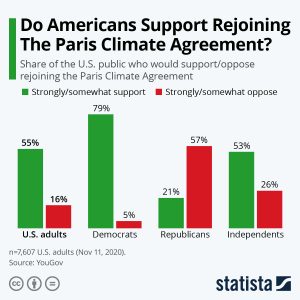Did Biden Make the Right Decision in Rejoining the Paris Climate Agreement?
President Biden signed an executive order to rejoin the Paris Climate Agreement on January 20, 2021.
On January 20, 2021, President Biden signed an executive order to rejoin the Paris Climate Agreement. Just 107 days before, the United States officially left this agreement under former President Trump’s administration. The agreement is a legally binding international treaty on climate change with the goal of limiting the increase in Earth’s temperature to 1.5 to 2 degrees Celsius compared to pre-industrial levels. These efforts are taken in order for the Paris Agreement to meet its goal of reducing greenhouse gas emissions to prevent steep rising in global temperatures.
Former President Obama accepted the Paris Agreement by executive order in September 2016, and committed $3 billion dollars to the Green Climate Fund. Some Americans opposed this decision by arguing that the agreement is bad for American taxpayers, energy companies, and people who rely on affordable energy. In June 2017, Trump declared that the United States was withdrawing from the agreement. However, regulations require that countries must be in the agreement for 4 years before leaving, so official withdrawal took place in November 2020. This withdrawal was opposed by most Americans, the majority of opposers being Democrats, scientists, and environmentalists. Nevertheless, some Americans approved of the withdrawal. It is important to address the positive and negative effects of joining the agreement, but saving our planet is a bigger priority than a chip at the economy of our country.

According to NASA, global warming is the result of “human activity since the mid-20th century and [is] proceeding at a rate that is unprecedented over decades to millennia.” Humans contribute to the steep rise in heat-trapping gases, such as carbon dioxide, through the burning of fossil fuels for electricity, heat, and transportation. This rise in dangerous gas levels have caused the planet’s average surface temperature to raise 2.12 degrees Fahrenheit (1.18 Celsius) in a little over a century. While that may seem like a small number over a long period of time, most of the warming occurred in the past 40 years, with the past 7 years being the hottest.
Rising temperatures have caused Greenland to lose an average of 279 billion tons of ice per year, and Antarctica to lose about 148 billion tons of ice per year between 1993 and 2019. Polar bears have become a threatened species since 2008. Polar bears require ice to hunt seals in order to survive, so the decline in ice has made food scarce, causing many polar bears to starve to death. While this is tragic on its own, polar bears are not the only animals affected by global warming. Other various Arctic species, including walruses and seals, are at risk of endangerment due to the decline in sea ice which is used as their habitat, a place to hunt, and a place to hide from predators.
Other wildlife that are largely at risk from global warming include moose, salmon, sea turtles, and coral. For moose, milder winters and less snow leads to higher numbers of winter ticks. Tens of thousands of these parasites can gather on a single moose to feed on its blood. This weakens the animal’s immune system and often causes death, especially in the calves. Salmon require cold, flowing water to lay their eggs, so rising water temperatures in the Pacific Northwest prevent salmon from spawning new generations of fish. Warmer water also allows fish-killing parasites into Alaskan rivers. If temperatures continue to rise, the commercial and recreational fishing industries are going to be majorly impacted by losing business. Similar to salmon, spawning locations for sea turtles are inhibited since rising sea levels threaten to demolish the turtles’ nests. Sea turtles, often the face of climate change, are being put in danger. Sea levels have risen about eight inches in the past century, and are projected to rise an additional one to eight feet by 2100, which is not promising for sea turtles. By 2050, corals are expected to become rare due to the acidification of the sea water. Since the Industrial Revolution, the acidity of surface ocean waters has increased by about 30% due to humans emitting more carbon dioxide into the atmosphere, which is being absorbed into the ocean. Coral reefs are home to many creatures, and the loss of them will cause a great disruption to the food web of the ocean.
While creatures are subject to endangerment with rising temperatures, so are humans. Another effect of climate change is stronger and more intense hurricanes. One of the last major hurricanes, Florence, caused at least 51 deaths and immense damage to both North and South Carolina. Why would we continue to let our planet be destroyed when there is action we can take to save it?
The Paris Agreement brings countries together to save our planet by working in five-year increments with plans to limit the production of greenhouse gases: the cause of climate change. Every five years, countries share their plans, called nationally determined contributions (NDCs), which communicate how they will take action to reduce greenhouse gas emissions. Developed countries within the agreement are responsible for providing financial assistance to less endowed countries that may fall vulnerable to emissions issues. In the long run, it is worth losing a few dollars rather than losing our planet.
This is Grace's first year as a staff writer for Prospect.

Isabelle is the Photography Editor for Prospect. This is her third year as a photographer on the Prospect staff.


![[Charlie Kirk] by [Gage Skidmore] is licensed under [CC BY-SA 2.0].](https://flhsprospect.com/wp-content/uploads/2025/09/charlie-kirk-article-600x400.jpg)



